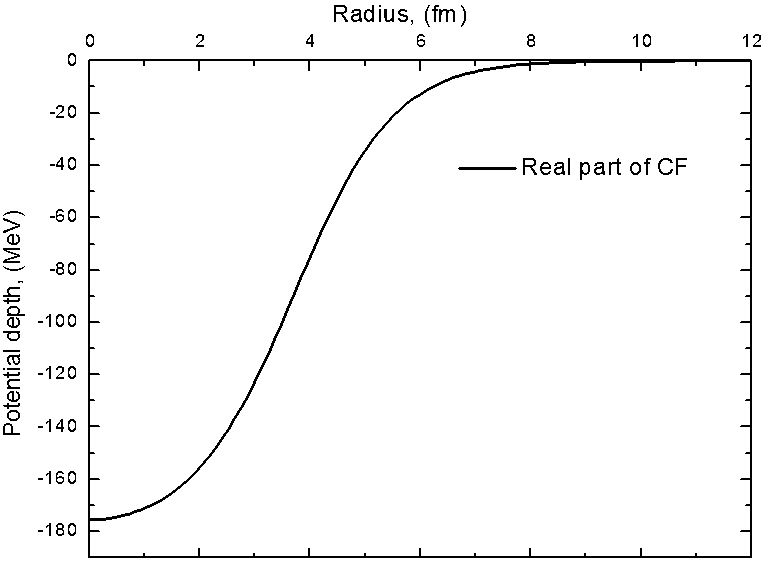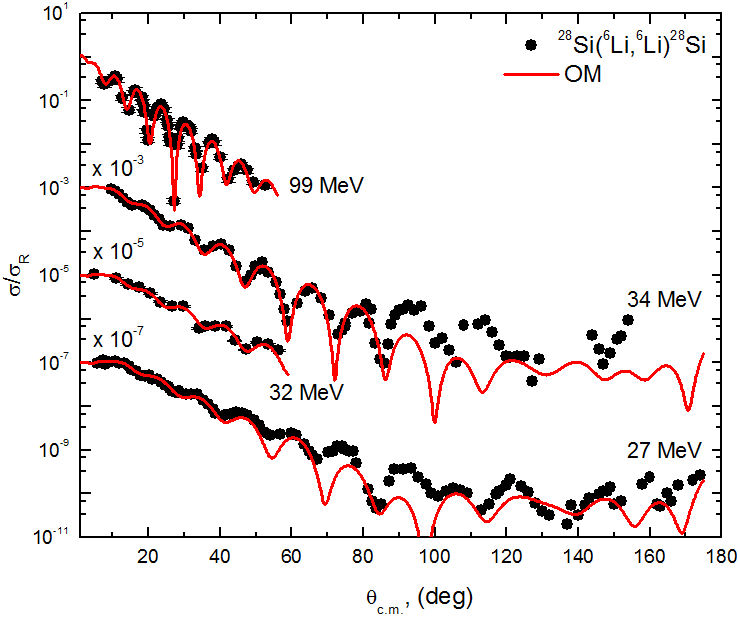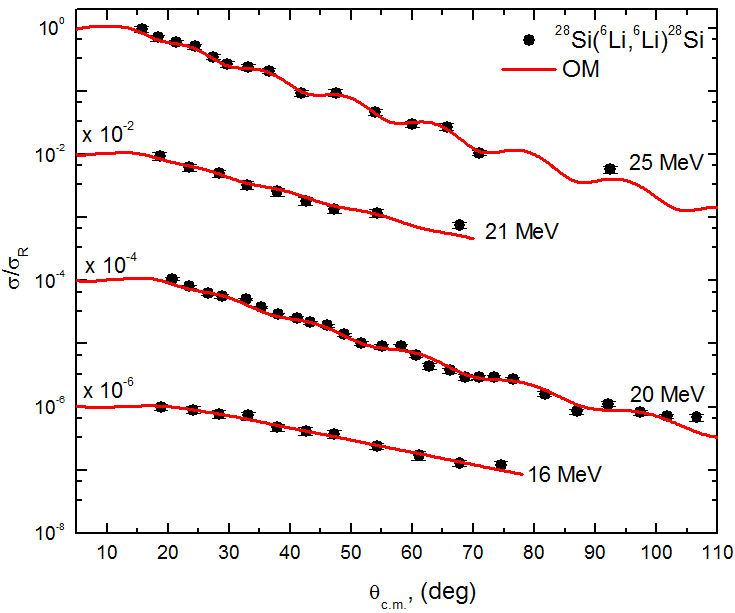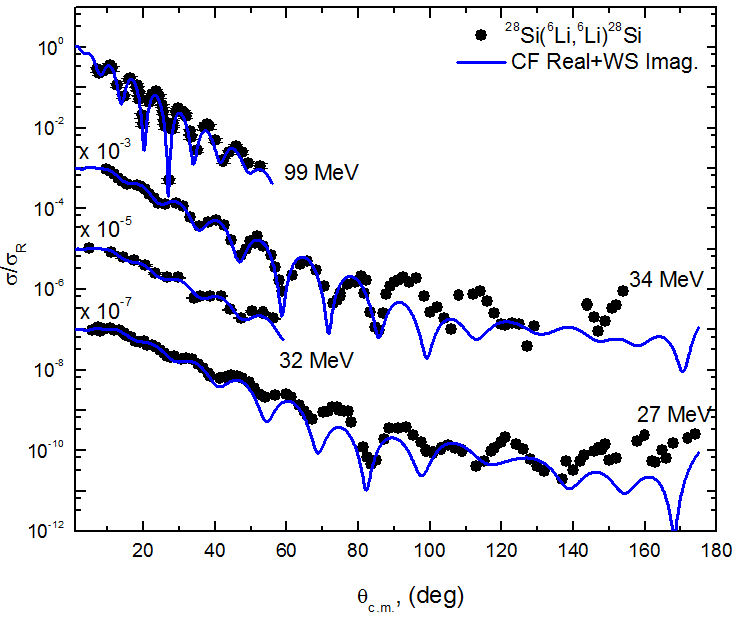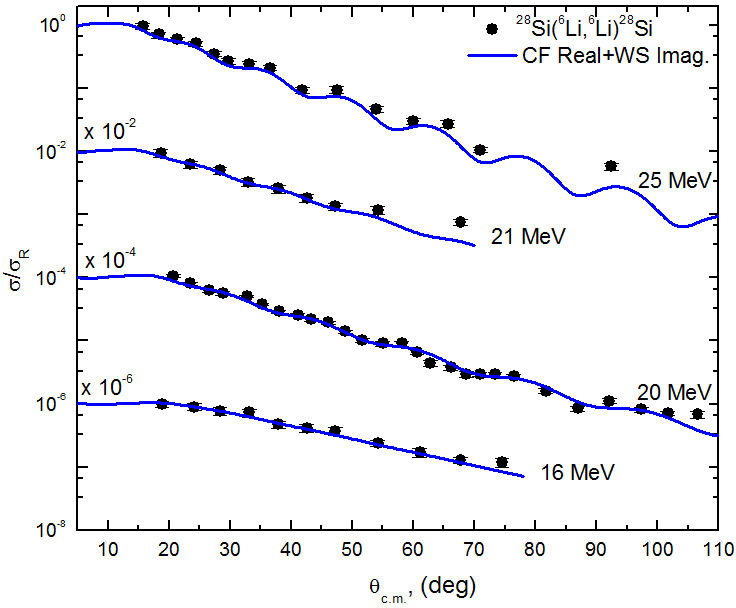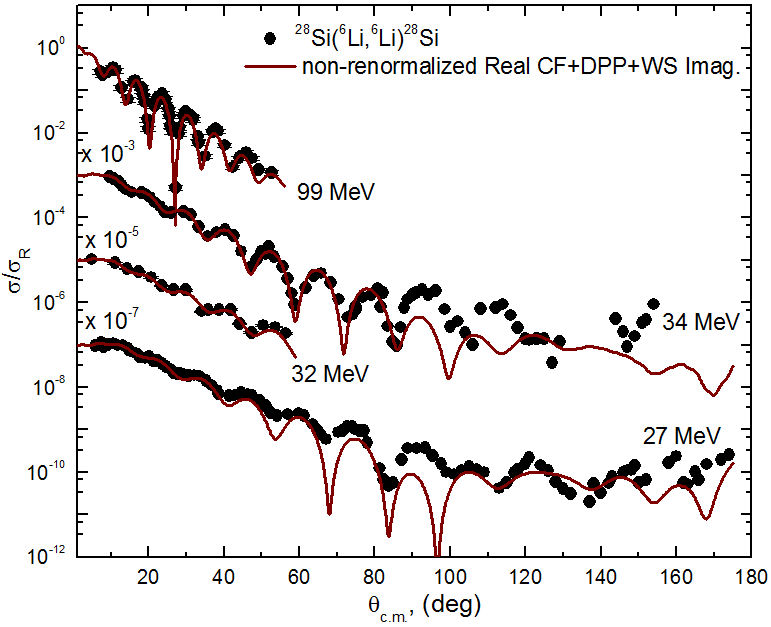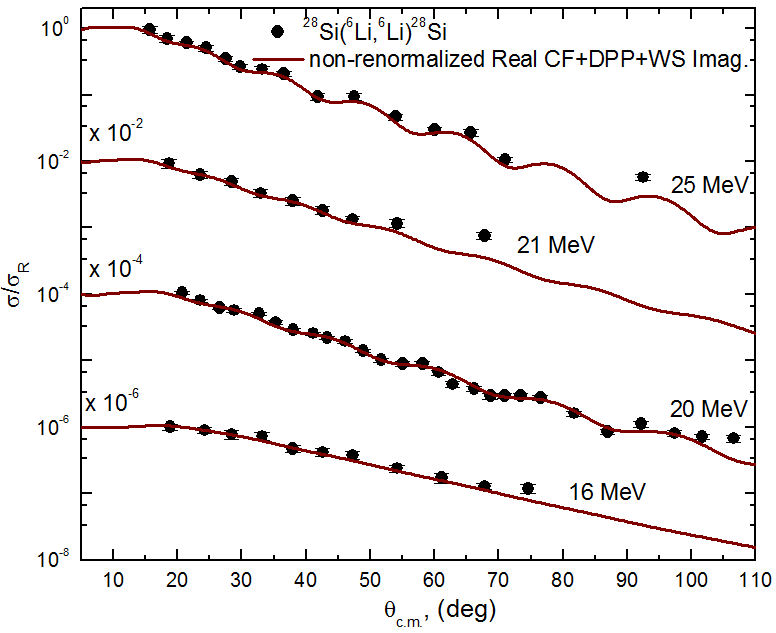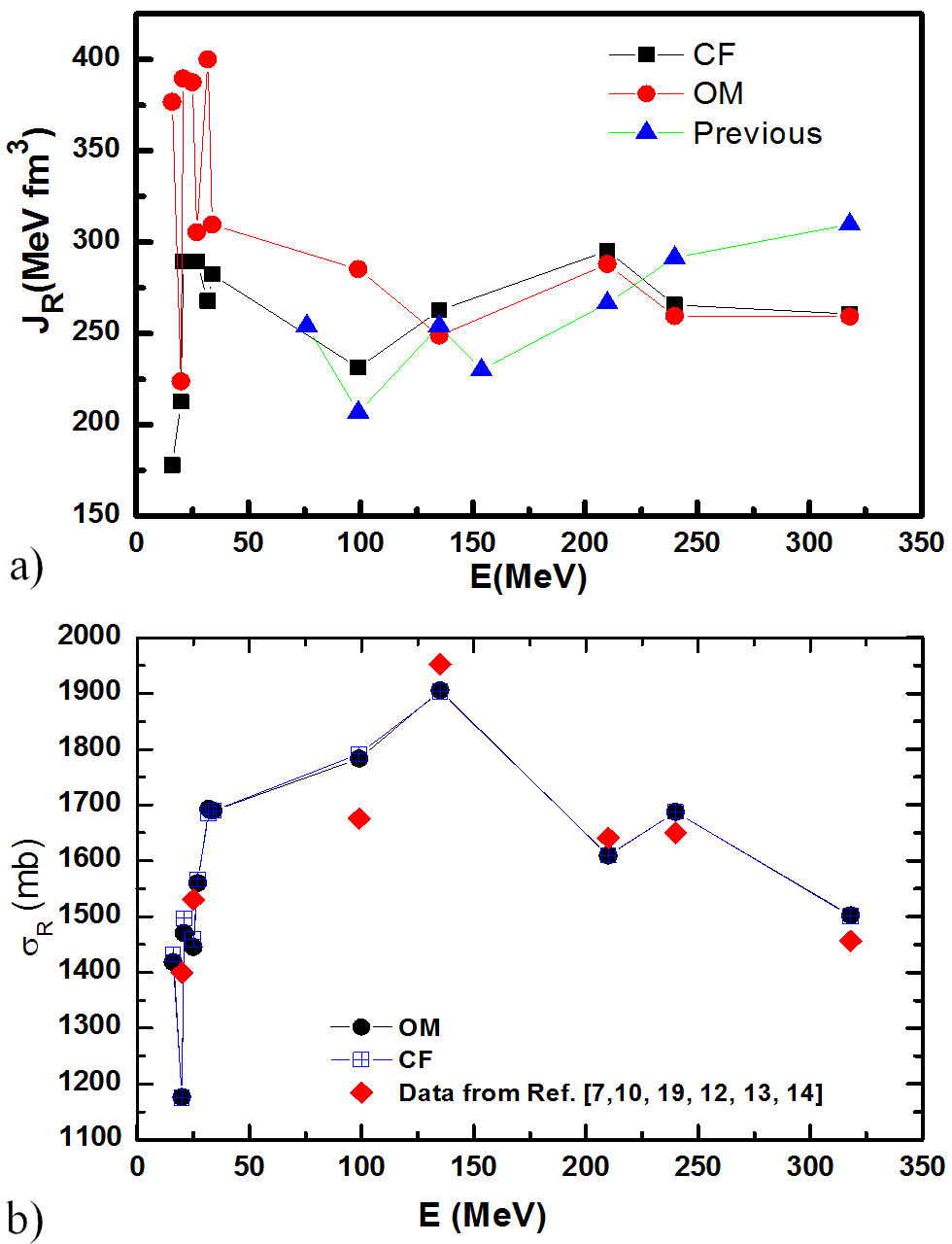1. Introduction
The study of nuclear processes induced by weakly bound nuclei such as 6Li, 7Li, 10Be, 11Be, has attracted plenary attention for years. Especially, the processes induced by 6Li and 7Li nuclei gained attention due to the break-up effect of 6Li into d + α, and 7Li into t + α which plays a crucial role in the elastic scattering of 6Li and 7Li, for a range of target nuclei at different energies. There are extensive experimental measurements and theoretical studies for 6Li + 28Si nuclear system, and the available data are classified into two categories: experimental data near the Coulomb barrier energy EC [1-7] and the data above EC [8-14]. It is appropriate here to disregard particular effects due to coupling to other reaction channels when studying the elastic scattering mechanisms between two ions at energies well above the EC. In this case, the elastic scattering data can be reproduced well by utilizing the conventional optical and folding potentials. On the other hand, at energies near the EC, the coupling effects are significant and appear in various reaction channels. Pakou et al. [1] measured the angular distributions for 6Li + 28Si at four near barrier energies −7.5, 9, 11, and 13 MeV - over a wide angular range. The data were analyzed using optical potential with the real part derived based on double folding (DF) potential. It was found that the strength of the real part of potential remains almost independent of the energy, and in order to reproduce the data, a reduction in the renormalization factor by about 40% is necessary. Sinha et al. [5] measured the angular distributions for 6Li + 28Si at energies 16 and 21 MeV. The measured data, as well as the data at lower energies, were fitted using optical potentials of both imaginary volume and surface parts. The effect of the break-up on elastic scattering was investigated within the Continuum Discretized Coupled Channels (CDCC) method. Experimental data at high energies [10-14] showed refractive features at forwarding angles region, in contrast to the data at low energies close to EC. Nadasen et al. [14] measured the angular distribution for 6Li + 28Si at 318 MeV; the data extend well beyond the rainbow angle into the region where the far-side scattering dominates. The data were reproduced reasonably well using DF potential without renormalization. The data at high energies [8-14] were also subjected to various optical model (OM) and DF analysis. The 6Li + 28Si system has been subjected to several theoretical studies [1521] recently, which were devoted to investigating this nuclear system either at low and high energies using different pure OM and DF potentials. M. Anwar [17] analyzed the experimental angular distributions of 6Li scattered elastically by different targets −24Mg, 28Si, 40Ca, 48Ca, 58Ni, 90Zr, and 116Sn - at E lab (6Li) = 240 MeV. The data were analyzed using the conventional OM potential as well as DF of two different effective density independent nucleon-nucleon NN interactions namely S1Y and M3Y. The analysis incorporated four different forms of 6Li density distribution with rms radii ranging from 2.195 to 2.444 fm. The DF analysis, for the concerned data, showed that the strength of the real part of potential should be reduced by a factor of ≈ 28% - 0.36%. M. A. Hassanain et al. [19] investigated the 6Li + 28Si elastic scattering at six energy sets ranging from 76 to 318 MeV, using two approaches. In the first approach, the full α cluster structure of the interacting nuclei was considered, where 6Li was described in terms of d−α cluster model wave function, and the 28Si nucleus was described as 7α. In the second approach, the real part of the potential was constructed based on the CDM3Y6 Paris NN interaction. They reported that the quality of fitting directly proportional to the energy, as expected, and a renormalization factor of ≈ 0.43 − 1.0 is required to fit the data.
Yongli Xu et al. [21] performed a systematic global optical model description for 6Li projectiles scattered elastically from targets ranging from 24Mg to 209Bi at energies below 250 MeV. The obtained global optical potential from this study was found to be applicable for different elastic scattering processes induced by 6Li. The obtained potential is also used to predict the reaction cross sections for targets outside the concerned mass range.
Y. Sakuragi [22] studied the projectile break-up effects on the elastic scattering of 6Li from different targets with a mass number (α = 12 − 208). The 6Li break-up effects were investigated, within the framework of the CDCC method, in the elastic scattering cross-sections with interaction potentials extracted from the M3Y DF potential. The calculations could reproduce the experimental elastic scattering data for all the studied targets and incident energies without any renormalization for the folded potential if an additional term “Dynamic Polarization Potential DPP” was introduced. The DPP has a repulsive real part with a strength of ≈ 40% of the folding potential. For nucleons, α−particles and heavy ions (α P ≥ 10), at energies up to 20 MeV/nucleon, the folding potential is successful in fitting the experimental data with N R ≈ 1.0. However, the optical potential for 6,7 Li [22-26], based on a folding model, has been found unsuccessful since the values of N R required in order to fit the data are much smaller than unity. Theoretical studies for 6Li-target systems present a problem in the DF model description, where the real potential requires a renormalization of approximately one-half in order to reproduce the data. Branden et al. [27] assumed that this is due to the importance of break-up channels for the loosely bound 6Li nucleus, represented by a complex DPP, which has a strongly repulsive real part. It is to be noted that several theoretical calculations [22,28,29], including CDCC calculations, showed that the renormalization factor is close to unity when the coupling to break-up channels is included.
The available experimental measurements for 6Li + 28Si system at high energies and over sufficiently wide angular range reveal several ambiguities associated with the different concerned potentials. In the present work, the 6Li + 28Si nuclear system is subjected to further investigation. Firstly, a new systematic global description for the data is obtained using the conventional OM potential of fixed radii parameters. Secondly, motivated by the well-known cluster nature of 6Li, the data are reanalyzed from the microscopic point of view in the cluster folding optical model (CFOM) framework. The 6Li + 28Si angular distributions data are plotted as a function of momentum transfer, and they showed that the same real part of potential could be used to reproduce the data at different energies as they exhibit the same oscillatory behavior in the forward angle region. Finally, the concerned data are well described using non-renormalized real cluster folding potential when an additional dynamical polarization term is added.
The paper is organized as follows. In Sec. 2, the theoretical calculations for 6Li + 28Si system based on both optical and cluster folding potentials are described. Section 3 is devoted to the discussion of the results and the summary is given in Sec. 4.
2. Theoretical calculations
Using the phenomenological OM potential and semi microscopically using CFOM potential, the elastic scattering angular distributions for 6Li + 28Si nuclear system in the energy range 16 − 318 MeV are reanalyzed in order to obtain the global potential, which could reproduce the data in this wide range of concerned energies.
2.1. Data analysis within the framework of OM
The elastic scattering angular distributions for 6Li + 28Si nuclear system at energies 16 MeV [5], 20 MeV [6], 21 MeV [5], 25 MeV [7], 27 MeV [8], 32 MeV [9], 34 MeV [8], 99 MeV [10], 135.1 MeV [11], 210 MeV [12], 240 MeV [13], and 318 MeV [14] are investigated within the framework of OM. The parameters considered by A. Nadasen et al. [12] are taken as starting parameters. The analyses employed Coulomb potential as well as real and imaginary volume central potentials. As the influence of spin-orbit interaction for 6Li is small, it has been excluded. The used potential is represented in the following form:
Here f(r,r
x
, α
x
), x = V , W is the
Woods-Saxon (WS) form factor (1 + exp[r − r
x
α
1/3
)/α
x
])−1 and V
C
(R) is the Coulomb potential due to a uniform sphere
with a charge equal to that of the target nucleus and radius
where N is the number of experimental data points. σ(θ i )cal and σ(θ i )exp are the calculated and experimental crosssections, while ∆σ(θ i ) is the relative uncertainty in experimental data.
2.2. Data analysis within the framework of CFOM
Considering the appreciable cluster probability of 6Li as a weakly bound α + d system, we try to describe the 6Li elastically scattered from 28Si nucleus using a simple CFOM. In this model, the real part of 6Li + 28Si potential is generated based on cluster folding. For the well-known optical potential of α−particles and deuterons, we define the 6Li potential as:
where χ
αd
(r) is the intercluster wave function for the relative
motion of α and d in the ground state of
6Li, and r is the relative coordinate between the
centers of mass of α and d.
3. Results and discussion
The comparison between the experimental 6Li + 28Si elastic scattering angular distributions at E lab = 16 − 318 MeV and the theoretical calculations based on Woods-Saxon optical potential are shown in Figs. 2-4 and the extracted potential parameters are listed in Table I. The agreement between the experimental data and calculations is fairly good not only at all the concerned energies but also over the entire angular range. The χ 2 /N values obtained from this work are comparable to previously reported values [5-14]. Although the radius parameter for both the real and imaginary potential parts are fixed during the search process for potential parameters, no clear dependence of real and imaginary potential depths on energy is obtained.

FIGURE 2 Comparison between experimental angular distributions data (solid black circles) and theoretical calculations for 28Si(6Li,6Li)28Si elastic scattering at E lab = 318, 240, 210, and 135.1 MeV. The solid red curves denote OM fits.
TABLE I Global optical potential parameters for 6Li + 28Si nuclear system extracted from the OM analysis, the values of reaction cross sections σR as well as real JV and imaginary JW volume integrals are also listed.
|
E (MeV) |
V0 (MeV) |
rV (fm) |
αV (fm) |
W0 (MeV) |
rW (fm) |
αW (fm) |
χ2 /N |
σR (mb) |
JV (MeV.fm3) |
JW (MeV.fm3) |
| 16 | 189.9 | 1.299 | 0.684 | 34.9 | 1.703 | 0.941 | 0.29 | 1419 | 376.87 | 159.67 |
| 20 | 101.75 | 1.299 | 0.829 | 26.65 | 1.703 | 0.701 | 3.2 | 1177 | 223.65 | 108.86 |
| 21 | 189.9 | 1.299 | 0.732 | 45.0 | 1.703 | 0.794 | 1.13 | 1470 | 389.42 | 191.27 |
| 25 | 186.05 | 1.299 | 0.754 | 37.28 | 1.703 | 0.737 | 3.01 | 1445 | 387.44 | 154.32 |
| 27 | 140.63 | 1.299 | 0.812 | 15.78 | 1.703 | 0.938 | 19.9 | 1560 | 305.29 | 72.08 |
| 32 | 189.9 | 1.299 | 0.77 | 34.9 | 1.703 | 0.827 | 11.7 | 1693 | 399.96 | 150.72 |
| 34 | 130.9 | 1.299 | 0.926 | 20.39 | 1.703 | 0.922 | 27.3 | 1690 | 309.47 | 92.37 |
| 99 | 139.17 | 1.299 | 0.731 | 31.51 | 1.703 | 0.86 | 2.5 | 1783 | 285.19 | 138.31 |
| 135.1 | 109.8 | 1.299 | 0.87 | 30.53 | 1.703 | 0.95 | 5.4 | 1905 | 248.81 | 140.33 |
| 210 | 129.9 | 1.299 | 0.84 | 33.52 | 1.703 | 0.782 | 3.97 | 1609 | 287.85 | 141.67 |
| 240 | 117.01 | 1.299 | 0.841 | 29.17 | 1.703 | 0.891 | 2.3 | 1687 | 259.48 | 130.05 |
| 318 | 115.3 | 1.299 | 0.86 | 30.32 | 1.703 | 0.783 | 3.9 | 1502 | 259.32 | 128.20 |
In CFOM, the theoretical calculations are performed using a real part of the potential derived based on mentioned cluster folding “see Eq. (3)” in addition to an imaginary Woods-Saxon term. Thus, the nuclear potential takes the following shape:
The comparison between the experimental angular distributions for 6Li + 28Si elastic scattering and the theoretical calculations performed within the framework of CFOM are shown in Figs. 5-7, while the potential parameters are listed in Table II. The same potential parameters for the imaginary volume term, extracted from the OM analysis, are kept the same in CFOM calculations. Consequently, the data are fitted using only one parameter- N RCF , “which is the renormalization factor for the real part of potential derived based on cluster folding”. As shown in Figs. 5-7, the agreement between the experimental data and the calculations is good, and the χ 2 /N values are close to those obtained from OM analysis or even better at some energies. The extracted average value for N RCF is 0.732±0.1, indicating that the strength of N RCF should be reduced by about 27% in order to reproduce the data. The same problem was reported previously in DF analysis for 6Li + X nuclear systems, where X is a different target nucleus such as 12C, 16O, 28Si.
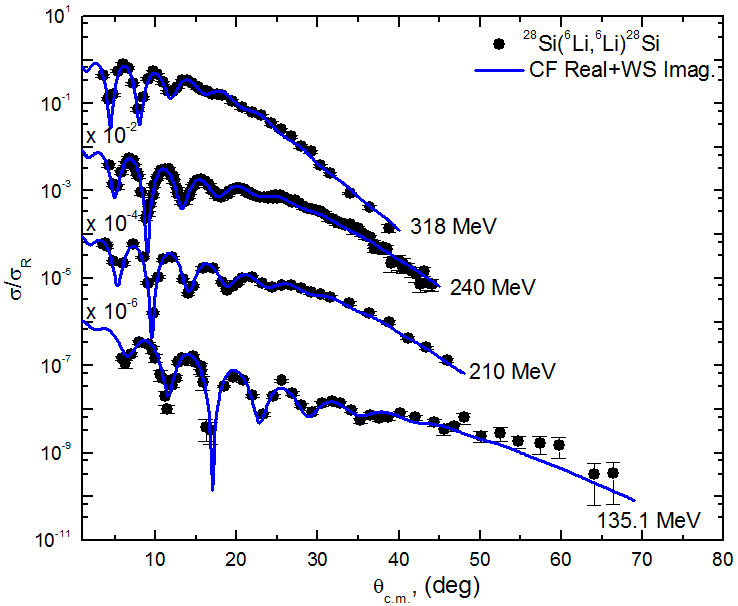
FIGURE 5 Comparison between experimental angular distributions data (solid black circles) for 28Si(6Li,6Li)28Si elastic scattering and the theoretical calculations (solid blue curves) using CFP plus an imaginary WS potential at E lab = 318, 240, 210, and 135.1 MeV.
TABLE II Potential parameters for 6Li + 28Si nuclear system extracted from the CFOM analysis, the values of reaction cross sections σ R as well as real JV and imaginary JW volume integrals are also listed.
|
E (MeV) |
NRCF |
W0
(MeV) |
rW (fm) |
αW (fm) |
χ2/N |
σR (mb) |
JV (MeV.fm3) |
JW (MeV.fm3) |
| 16 | 0.5±0.01 | 34.9 | 1.703 | 0.941 | 0.58 | 1432 | 177.77 | 159.67 |
| 20 | 0.598±0.01 | 26.65 | 1.703 | 0.701 | 3.2 | 1175 | 212.61 | 108.86 |
| 21 | 0.814±0.01 | 45.0 | 1.703 | 0.794 | 2.47 | 1497 | 289.42 | 191.27 |
| 25 | 0.814±0.01 | 37.28 | 1.703 | 0.737 | 6.2 | 1459 | 289.42 | 154.32 |
| 27 | 0.814±0.01 | 15.78 | 1.703 | 0.938 | 26.4 | 1567 | 289.42 | 72.08 |
| 32 | 0.753±0.01 | 34.9 | 1.703 | 0.827 | 15.9 | 1684 | 267.73 | 150.72 |
| 34 | 0.794±0.01 | 20.39 | 1.703 | 0.922 | 30.1 | 1690 | 282.31 | 92.37 |
| 99 | 0.65±0.01 | 31.51 | 1.703 | 0.86 | 6.1 | 1791 | 231.11 | 138.31 |
| 135.1 | 0.739±0.01 | 30.53 | 1.703 | 0.95 | 6.7 | 1903 | 262.75 | 140.33 |
| 210 | 0.83±0.01 | 33.52 | 1.703 | 0.782 | 4.16 | 1610 | 295.11 | 141.67 |
| 240 | 0.747±0.01 | 29.17 | 1.703 | 0.891 | 1.99 | 1687 | 265.60 | 130.05 |
| 318 | 0.733±0.01 | 30.32 | 1.703 | 0.783 | 4.6 | 1501 | 260.62 | 128.20 |
The elastic scattering angular distributions for the 6Li + 28Si
nuclear system at the different concerned energies are plotted as a function of
momentum transfer as shown in Fig. 8. The data
at relatively higher energies displayed a complex oscillatory behavior with periodic
structures of different periods at forwarding angles. The interference peaks and
valleys line up, whereas if they are plotted as a function of angle, there is not an
apparent pattern. The formula q = 2k
sin(θ
c.m
/2) is used to calculate the cross-sections as a function of
momentum, where k is the wavenumber. The wavenumber was taken to be
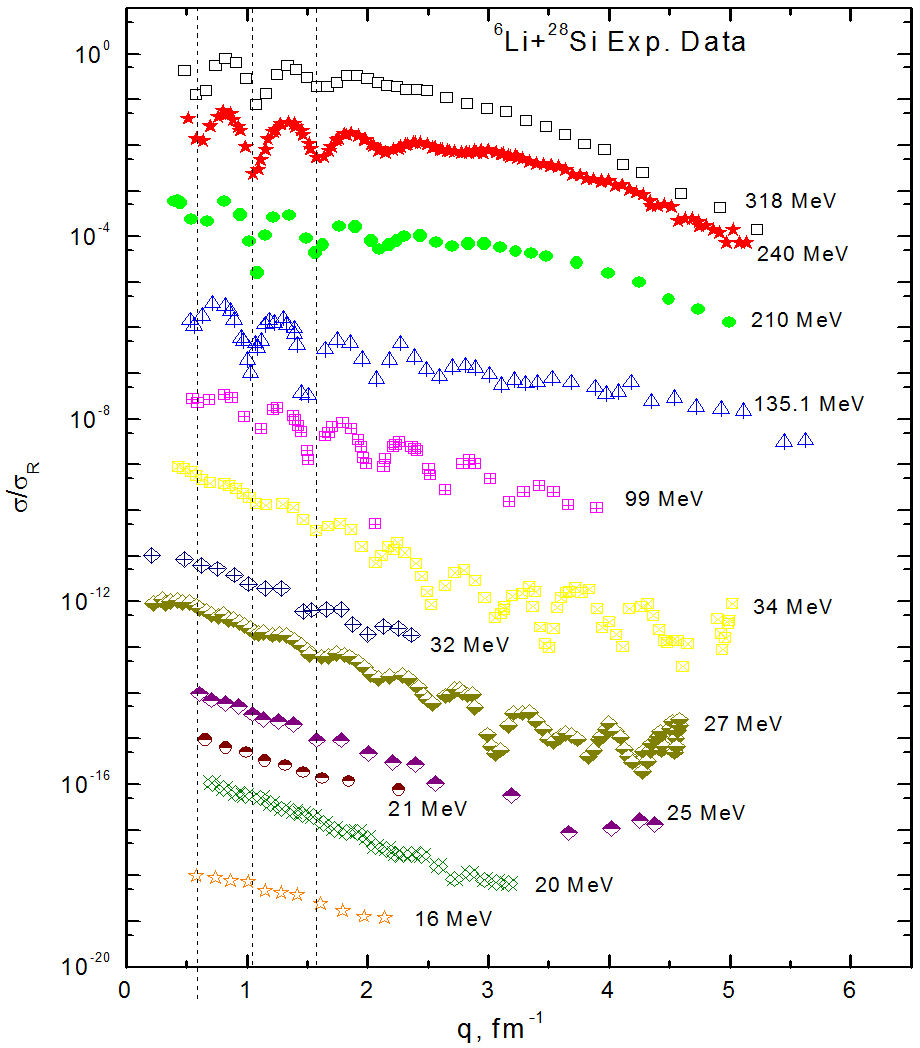
FIGURE 8 Experimental angular distributions for 6Li + 28Si elastic scattering at energies E lab =16−318 MeV plotted as a function of momentum transfer.
The strong absorption at relatively high energies leads to refractive features such as the nuclear rainbow followed by structure-less falloff, as shown in Fig. 8. The possibility of seeing such refractive features was first realized in the scattering of alpha particles [34]. A few years later, hints emerged that similar but weaker effects were seen in the scattering of light heavy-ions 6Li [11,35] and 12C [36,37]. By now, many examples of refractive phenomena in light heavy-ion systems have been collected already.
Previously microscopic analysis for the 6Li + 28Si system presented a problem in the DF, where the real part of potential required a renormalization of approximately one-half in order to reproduce the data, and it was assumed that this is due to the importance of break-up channels for the loosely bound 6Li nucleus. The analysis of 6Li + 28Si scattering data using real CFP in the current work also showed the same trend, as N RCF should be reduced by about 27% in order to reproduce the data. The cluster folding calculations are repeated using non-renormalized real CFP “N RCF = 1” with the same, previously obtained imaginary WS potential plus a dynamical polarization potential (surface potential with a repulsive real part designed to simulate the polarization effects caused by the projectile break-up). The used DPP is characterized by three parameters (V pol, r pol, α pol), and their corresponding values at the different concerned energies are listed in Table III. The comparisons between the experimental data and theoretical calculation performed using the non-renormalized real CFP plus the dynamical polarization potential are shown in Figs. 9-11, and they show the same good agreement as in Figs. 5-7.
TABLE III Potential parameters for 6Li + 28Si system at different energies using non-renormalized real CFP “NRCF = 1.0” plus DPP “surface potential with a repulsive real part” in addition to an imaginary WS potential, rW is fixed to 1.703 fm.
|
E (MeV) |
NRCF |
W0 (MeV) |
rW (fm) |
αW (fm) |
χ2/N | Vpol | rpol | αpol |
| 16 | 1.0 | 34.9 | 1.703 | 0.941 | 0.8 | -30.14 | 1.0 | 0.89 |
| 20 | 1.0 | 26.65 | 1.703 | 0.701 | 3.3 | -30.19 | 1.0 | 0.89 |
| 21 | 1.0 | 45.0 | 1.703 | 0.794 | 2.8 | -20.51 | 1.0 | 0.805 |
| 25 | 1.0 | 37.28 | 1.703 | 0.737 | 4.3 | -20.49 | 1.0 | 0.89 |
| 27 | 1.0 | 15.78 | 1.703 | 0.938 | 23.8 | -20.79 | 1.0 | 0.8 |
| 32 | 1.0 | 34.9 | 1.703 | 0.827 | 16.6 | -29.79 | 1.0 | 0.82 |
| 34 | 1.0 | 20.39 | 1.703 | 0.922 | 30.5 | -29.79 | 1.0 | 0.82 |
| 99 | 1.0 | 31.51 | 1.703 | 0.86 | 4.7 | -23.88 | 1.1 | 0.9 |
| 135.1 | 1.0 | 30.53 | 1.703 | 0.95 | 6.5 | -23.72 | 1.1 | 0.806 |
| 210 | 1.0 | 33.52 | 1.703 | 0.782 | 4.2 | -17.68 | 1.0 | 0.882 |
| 240 | 1.0 | 29.17 | 1.703 | 0.891 | 1.7 | -27.98 | 1.0 | 0.839 |
| 318 | 1.0 | 30.32 | 1.703 | 0.783 | 5.2 | -29.31 | 1.0 | 0.823 |
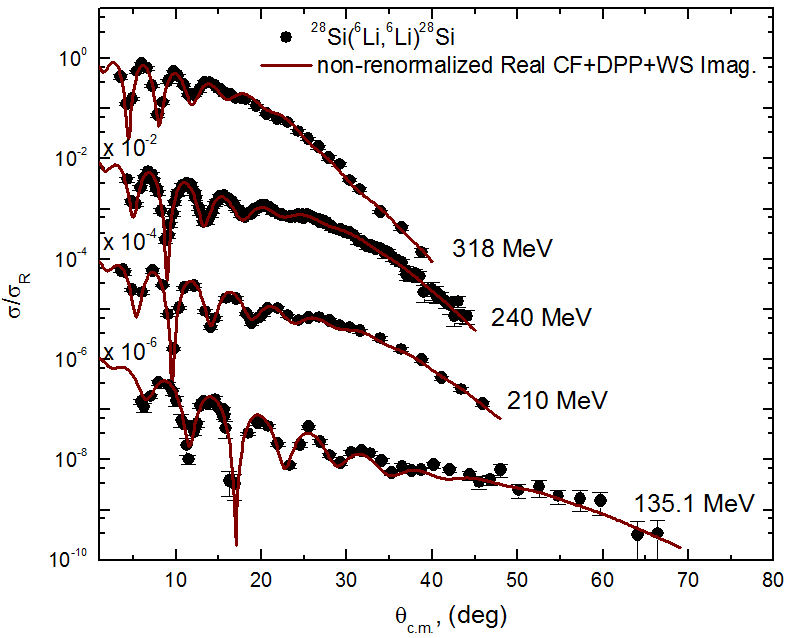
FIGURE 9 Comparison between experimental angular distributions data (solid black circles) for 28Si(6Li,6Li)28Si elastic scattering and the theoretical calculations (solid brown curves) using nonrenormalized real CFP plus a DPP term in addition to an imaginary WS potential at E lab =318, 240, 210, and 135.1 MeV.
The best-fitting OM and CFOM parameters, with the corresponding calculated real and imaginary volume integrals per interacting nucleon pair (J R and J i ) as well as the total reaction cross sections σ R in mb, are presented in Tables I and II, respectively. The extracted values for the total reaction cross-section σ R as well as the real volume integral are described graphically in Fig. 12. As shown in this figure, the σ R for CF and OM potentials has approximately the same energy behavior. After comparison, we found that the extracted values of σ R and J R are in good agreement with the previously reported values from Refs. [7,10,12-14,19].
4. Summary
The experimental angular distributions for 6Li + 28Si at E lab = 16 − 318 MeV are reanalyzed using Woods- Saxon OM potential consisting of four varying parameters −V 0, α V , W 0, and α W depth and diffuseness for both the utilized real and imaginary volume terms while, the radii parameters −r V and r W were kept fixed. The agreement between the experimental data and the theoretical calculations is reasonably good not only at the different concerned energies but also over the entire angular range. These data are also reanalyzed within the framework of CFOM. In this model, the real part of the potential was constructed on the basis of cluster folding, while the imaginary part was taken in the WS form as in OM analysis using the same parameters. In this case, the data are fitted with only one parameter- N RCF . The obtained average value of N RCF is 0.732 ± 0.1, suggesting that the strength of N RCF should be reduced by about 27% in order to reproduce the data. The same problem was reported previously in DF analysis for the 6Li + 28Si nuclear system. Calculations performed using non-renormalized real CFP, “i.e, N RCF = 1” could reproduce the data fairly by introducing a DPP surface potential term with a repulsive real part to simulate the polarization effects caused by 6Li break-up. Finally, the experimental data for the 6Li + 28Si nuclear system, plotted as a function of momentum transfer, showed interference peaks and valleys line up and exhibit dips form at the momentum transfers around q = 0.59, 1.05, and 1.58 fm−1 that can be followed down to an energy of 34 MeV. Consequently, it should be shown that the forward angle dips are produced by the same “potential” and the differences between the crosssections at different energies, at larger momentum transfer (angles), are due to the absorption at larger values.











 nova página do texto(beta)
nova página do texto(beta)

